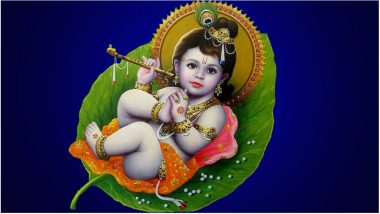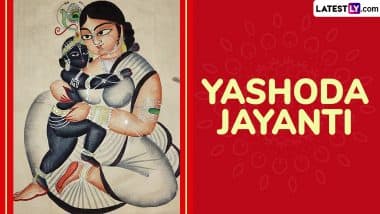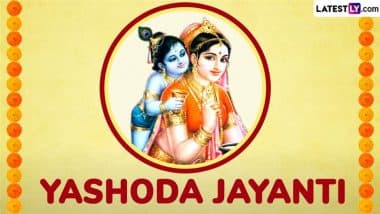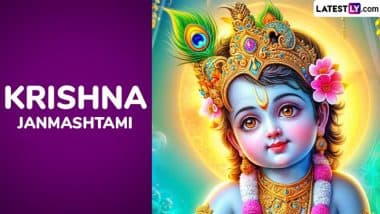Krishna Janmashtami is observed as the birth anniversary of Lord Krishna who is believed to be the eighth avatar of Lord Vishnu. On this auspicious occasion, the toddler form of the God which is known as Bal Gopal or Laddu Gopal is worshiped on Krishna Janmashtami. Devotees visit Krishna temples, worship the lord by praying and chanting mantras dedicated to the divine. In 2018, Krishna Janmashtami will be observed on September 2 and September 3. While September 2 will mark the birth anniversary, on the next day September 3, Dahi Handi, Lord Krishna’s favourite sport will be celebrated. The birth is celebrated according to the tithi timings and aarti is done at a given shubh muharat and a puja vidhi is performed. Krishna Janmashtami 2018: What Is The Significance of Lord Krishna’s Birth in Hinduism and Why Is It Celebrated?
During the Janmashtami puja apart from Lord Krishna, his birth parents Vasudeva and Devaki, his foster parents Nanda and Yashoda and siblings Lord Balarama and Subhadra are also worshipped. To celebrate the day, Lord Krishna temples are decorated with flowers, processions are carried out, bhajans and kirtans (devotional songs) are recited and everybody is in the joyous mood to celebrate their Lord’s birthday. Young boys dress up as Krishna and girls dress up like Radha. Special prasad is offered to the lord and later distributed among the devotees. Krishna Janmashtami 2018: How to Dress Your Daughter Like Radha on Gokulashtami Festival Celebrations (See Pics & Videos)
Krishna Janmashtami 2018 Puja Muharat & Tithi Timings
Nishita Puja Time: 11:58 pm (September 2) to 12:44 am (September 3) (according to Drikpanchang)
Ashtami Tithi Begins: 08:47 pm on (September 2)
Ashtami Tithi Ends: 07:20 pm on (September 3)
Krishna Janmashtami Puja Vidhi
The puja vidhi is done step by step while chanting specific mantras. The steps include: Dhyanam (meditation of Lord Krishna); Avahanam (chant mantra by joining hands in Aavahan Mudra by folding both thumbs inwards); Asanam (place five flowers in front of the idol); Padya (wash Lord Krishna’s feet with water); Arghya (offer water for head Abhishekam); Achamaniyam (offer water for sipping); Snanam (offer water for bathing); Vastra (offer Moli as new clothes); Yajnopavita (offer Yajnopavita to the lord); Gandha (offer scent); Abharam Hastabhushan (offer jewellery); Nana Parimala Dravya (offer various fragrance stuff to the idol); Pushpa (offer flowers to Krishna idol); Dhupam (offer dhupa while chanting mantra); Deepam (offer deep to Shri Krishna); Naivedya (offer Naivedya); Tambulam (offer paan leaves with betel nuts); Dakshina (offer gift to the lord); Maha Nirajan (offer aarti); Pradakshina (offer symbolic pradakshina - circumambulate from left to right of Shri Krishna); Namaskar (pay homage to the lord); Kshamapan (seek pardon from Shri Krishna for any known-unknown mistakes done during puja)
Fasting or Vrat on Krishna Janmashtami
Observing fast or vrat on sacred festivals such as Janmashtami is being followed by Hindus since ancient times. It is believed that fasting on Janmashtami is auspicious as when a devotee observes fast with true dedication, he achieves health, wealth and prosperities as written in the scriptures. Fasting on this day is believed to bring the devotees closer to the Supreme Being and he achieves salvation. There are two types of fast observed on Janmashtami – nirjal vrat and phalahar vrat. During nirjal vrat, devotees do not consume water or any kind of food for the entire day. And in phalahar vrat, devotees are allowed to drink water and milk and can also eat fruits. People generally follow phalahar vrat on Janmashtami.
Fasting Rules
There are certain rules that people need to follow when they are fasting on Janmashtami. Wake up early and take bath. Wear clean clothes and take a vow for keeping the fast. Clean the area of worship and offer milk, honey, yoghurt, ghee and sugar to the idol. Decorate the idol with new clothes and jewellery. Perform puja with complete rituals and perform aarti in the end. Sing bhajans and mantras dedicated to Lord Krishna. Parana (breaking the fast) should be done at the appropriate time. Do not consume non-vegetarian food, liquor, grains, pulses, peas and beans during the Janmashtami fast.
Krishna idols are placed in cradle and swung back and forth to symbolise his birth. Some women also draw tiny foot prints outside their doors, a symbol for Krishna’s journey into their homes. Krishna Janmashtami is followed by the festival of Nandotsav which celebrates the occasion when Nanda, foster father of Lord Krishna distributed gifts to the community in honour of Krishna’s birth. Janmashtami is the largest festival in Mathura where he was born and in Vrindavan where he grew up.
(The above story first appeared on LatestLY on Aug 02, 2018 10:17 AM IST. For more news and updates on politics, world, sports, entertainment and lifestyle, log on to our website latestly.com).










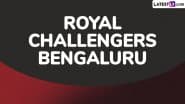
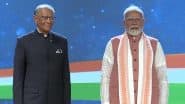

 Quickly
Quickly









